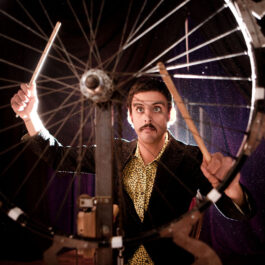Each month, American Express Essentials highlights one definitive literary work, old or new, and across any and all genres. The only determinant is quality: a book that makes life more vivid, more inspiring – a gifted piece of work you want to share. An absolute must-read.
Up this month is a thought-provoking masterpiece which belongs to the non-fiction category: Oliver Sacks’ classic The Man Who Mistook His Wife For A Hat.
The Man Who Mistook His Wife for a Hat and Other Clinical Tales – to give this work its full title, is a captivating book written by the late and much missed neurologist Oliver Sacks in 1985. He delves into the case studies of various patients with unique neurological conditions, including a poignant story about a patient with visual agnosia who was unable to recognise certain objects and faces – even that of his own wife. Sacks’ recount is both touching and at times grimly humourous: “He also appeared to have decided that the examination was over and started to look around for his hat. He reached out his hand and took hold of his wife’s head, tried to lift it off, to put it on. He had apparently mistaken his wife for a hat! His wife looked as if she was used to such things.” Through his eloquent writing, Sacks provides insightful commentary on the human brain and its complexities, making this work a literary masterpiece. If you’ve ever felt like you’re losing it, don’t hesitate to pick up this book.
Within the pages of Sacks’s account, readers will find a collection of twenty-four illuminating essays, each offering a unique perspective on the fascinating and complex world of brain function. Organised into four sections – “Losses,” “Excesses,” “Transports,” and “The World of the Simple” – the book presents a comprehensive exploration of the intricacies of neurological disorders. In the first two sections, the author delves into the deficits and excesses of brain function with a particular emphasis on the remarkable abilities of the right hemisphere of the brain. Moving on to the third and fourth sections, he explores the phenomenological manifestations of neurological disorders, including spontaneous reminiscences, altered perceptions, and the extraordinary qualities of mind found in those with intellectual disabilities. If there’s one thing this book is, that would be thought-provoking. It is one of those books you feel obligated to bring up in casual conversation. It comes as no surprise that this book “hit some nerve in the reading public”, in Sacks’ own words, and became an instant best-seller with successive generations since going on to discover its very particular shade of genius — it’s simply cut from a different cloth.
Through his meticulous documentation of extraordinary perceptual and intellectual aberrations, Dr Sacks offers readers an enrapturing look into the fascinating, yet often misunderstood world of neuroscience. From patients who have lost their memories and with them their sense of identity, to those who struggle to recognise familiar faces and objects, to those afflicted with uncontrollable tics and obsessions, the author skillfully demonstrates the complexities of the human mind and the ways in which neurological disorders can drastically alter one’s perception of reality. Through his moving portrayals of individuals dismissed as intellectually deficient, yet gifted with extraordinary artistic and mathematical talents, Dr Sacks challenges readers to reconsider what it means to be ‘normal’ and to celebrate the vast and awe-inspiring diversity of the human experience.
This book blurs the lines between science and art like no other; it pushes the human into the spotlight without pushing the science aside. Suddenly, what would otherwise remain as (yes, complex, but) physiological difficulties, turn into multidimensional human dilemas. With Sacks, one comes to understand that speech is more than just words: “speech – natural speech – does not consist of words alone, nor […] ‘propositions’ alone. It consists of utterance—an uttering-forth of one’s whole meaning with one’s whole being – the understanding of which involves infinitely more than mere word-recognition.”
Perhaps more importantly, one comes to realise that senses, those which we recognise, utilise and are used to, are only enough to the sane body (and mind), that, in Sacks’ own words, “there are other senses – secret senses, sixth senses, if you will – equally vital, but unrecognised, and unlauded. These senses, unconscious, automatic, had to be discovered.” Do bodies (and with them, minds) only function when we cannot feel them, when we’re not forced to question them? With so many existing deficits (and yes, surpluses), so many casualties, how can we be so lucky?
This is an exceptional literary work that may offer solace to those who have ever felt out of place or experienced a sense of losing control. Through the intricate and compelling case studies of his patients, Sacks demonstrates how the brain is capable of complex and often perplexing behaviours. He invites the reader to explore the intricacies of the human mind and to view neurological disorders from a more nuanced and empathetic perspective. The book’s eloquent prose, combined with Sacks’ compassionate approach, provides a comforting and thought-provoking read, one that leaves a lasting impression on its audience. For those seeking a deeper understanding of the human condition and the intricacies of the human mind, The Man Who Mistook His Wife for a Hat is the perfect literary choice.
This book stands as a riveting read that manages to be both profound and poignant. The author, a truly gifted writer, offers readers a unique blend of insight, intrigue, and compassion in equal measure. Through the captivating case studies of his patients, he explores the complexities of the human condition, leaving readers with a deeper understanding of the human psyche. With its masterful prose and empathetic approach, this book is not only a compelling work of non-fiction, but a moving testament to the resilience of the human spirit: “If we wish to know about a man, we ask ‘what is his story—his real, inmost story?’ for each of us is a biography, a story. Each of us is a singular narrative, which is constructed, continually, unconsciously, by, through, and in us—through our perceptions, our feelings, our thoughts, our actions; and, not least, our discourse, our spoken narrations. Biologically, physiologically, we are not so different from each other; historically, as narratives—we are each of us unique.” It is the perfect introduction to the depths and marvels of the human mind — especially for those who are not experts in this particular subject matter.
Given the delicate and intricate subject matter, it is no small feat that this literary gem can be appreciated by readers of all literary tastes. We swear by this last statement. Its compelling narrative and profound insights have the ability to captivate even those unfamiliar with the complexities of neuroscience. Indeed, the book’s accessibility serves as a testament to Sack’s ability to communicate complex ideas in an engaging manner. Whether one is a seasoned expert in the field or simply a curious soul, this book is sure to offer an enlightening and thought-provoking read to anyone with the curiosity and openness to delve into its pages.
Now, let’s get one thing straight: while this book is about neuroscience and psychiatry, it does not necessarily read as such. Instead, it stands as a testament to the author’s profound compassion and empathy towards his patients, imbuing the text with a deep sense of love and understanding. While Sack’s expertise in the field of neuroscience is evident and undisputable, what sets The Man Who Mistook His Wife For A Hat apart is his incredible ability to weave together complex scientific concepts with philosophical and spiritual themes. This is not a writer confined to scientific pursuit. Rather, it’s a humanist who has lived a rich life and who is owner to a vivid imagination and an unbounded sense of wonder.
Further Reading
If you were left in awe of Sacks’ acclaimed book, you’ll be happy to know it was turned into a one-act opera, produced by none other than Peter Brook. If what caught your attention was the way he creatively dealt with non-fiction, you can try reaching for David Foster Wallace’s “Consider the Lobster and Other Essays”. Cinephiles, meanwhile, will be captivated by the endearing portayal of Sacks by Robin Williams in the film Awakenings, also starring Robert De Niro, which was based on another Sacks book.














Sorry, the comment form is closed at this time.